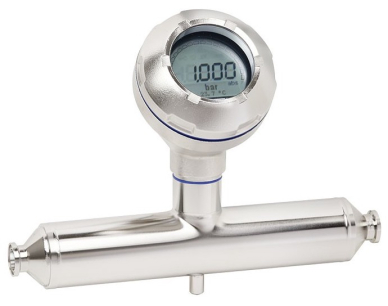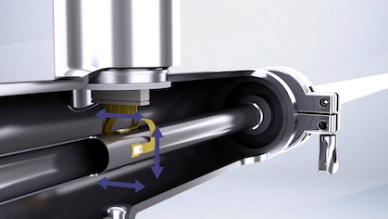The DMSU22SA in-line process transmitter is designed for the specific requirements and challenges of measuring pressure in aseptic applications. Its advantages: no fill fluid that could leak, no dead spaces to harbor bacteria, and a strong sensor tube that withstands extreme pressure surges.
The pharmaceutical and food & beverage industries rely on a variety of pressure measurement systems to monitor individual process parameters. To maintain aseptic conditions, the assorted valves, gauges, and sensors in a manufacturing facility must be cleaned regularly alongside the tanks and pipelines.
This sanitizing step is when pressure measuring instruments can get damaged. If that happens, production has to shut down and the failed instruments replaced. And if the diaphragm seal system leaks transmission fluid, the contaminated batch must be discarded. These are costly scenarios, as plants generally run nonstop, and a large amount of product will have already been ruined before operators can react.
What the food and pharma industries need is a stronger pressure monitoring system that uses a “dry” measuring cell.
The Problem with Steam-Induced Hammers in Sanitary Applications
Clean-in-place (CIP) and steam/sterilize-in-place (SIP) processes use water and cleaning agents under high pressure to sanitize everything that the aseptic product touches: tanks, pumps, pipelines, valves, and the measuring instruments’ wetted parts. Sometimes several cleaning cycles are necessary, finished off with an injection of sterile steam of up to 302°F (150°C).
This final step of the cleaning process is a critical moment. If water particles (from previous cleaning steps) remain in the pipeline when hot steam is introduced, the result is steam-induced water hammers. These explosive reactions can damage the pressure measuring instruments installed in the process.
What are steam-induced hammers, and what could they do to pressure instruments?
Steam-induced water hammers are hydraulic shocks created by the rapid condensation of hot gas. The volume of steam is more than 1,000 times that of water. So, when the hot steam comes into contact with cold water, it immediately collapses and shrinks to 1/1000th of its original volume.
In an open space, collapsing steam is not an issue. Inside a pipeline, however, this reaction creates a temporary vacuum. Cold condensate rushes into this void, resulting in a pressure surge that can harm pressure measuring instruments to the point of failure. In extreme cases, the pipe could rupture.
Steam-induced water hammers can also damage the diaphragm seals that separate the sanitary medium from the pressure instrument. This is a contamination risk because diaphragm seal systems contain a fill fluid that transmit pressure to the instrument. In case of a breach on the process side, this fluid will leak out into the product and contaminate it. Contamination can also occur with ceramic sensors; if damaged, these sensors immediately go into error mode, but the broken ceramic shards will have already entered the medium.
A Sanitary Pressure Measuring Solution That Withstands Extreme Process Conditions

DMSU22SA in-line process transmitter
In the past, with media that are too difficult for traditional pressure instruments to measure, the only way to avoid this contamination risk was to use a double-diaphragm system with an integrated monitoring mechanism. WIKA’s DMSU21SA warns operators if the diaphragm on the process side – the primary seal – is breached. Meanwhile, the secondary seal takes over to continue transmitting pressure and separate the fill fluid from the process medium.
Our latest solution for monitoring pressure in sterile processes further reduces the risk of contamination. The DMSU22SA in-line process transmitter does not use traditional diaphragm seals or transmission fluids. Rather, this “dry” pressure instrument has a thick-walled yet flexible sensor tube that becomes part of the process pipeline. The DMSU22SA’s 316L stainless steel inner tube is up to 25 times stronger than any diaphragm seal can be, making it highly resistant to steam-induced water hammers and other extreme process conditions.
How WIKA’s in-line transmitter monitors pressure and keeps processes safe

A Wheatstone bridge around the sensor tube measures the deformation and converts the strain into a usable value.
The DMSU22SA has a hermetically sealed inner sensor tube, an outer support tube, a wide range of process connections, and our UPT process transmitter with current output or HART® 7 protocol.
The patented sensor tube is slightly flattened. Pressurized fluid flowing through this elliptical tube causes it to return to its natural circular shape. As it does so, a Wheatstone bridge around the inner tube measures the deformation and converts the strain into a value that the transmitter then converts into a measuring signal. A platinum RTD provides active temperature compensation between −14°F and 176°F (−10°C and +80°C). This error compensation is up to 10 times better than with conventional devices, enabling more precise process control.
Between the sensor tube and the support tube is a vacuum. In the unlikely event that the inner tube is breached, the monitoring system detects pressure – as low as 20″ WC (50 mbar) – in this interstitial space, and the process transmitter will keep working but will display a “membrane rupture” alarm. In the HART® version, the protocol will also communicate a “membrane rupture” instrument status. If there is no bus control system, the breach can be relayed via a residual current. See this short video for a demonstration of how the DMSU22SA works.
Greater efficiency with an in-line pressure transmitter
Dead spaces, corners, and other entrapment zones are difficult to clean and sanitize properly, especially if the process medium is pasty, powdery, or crystallizing. The DMSU22SA is an in-line system with absolutely no dead spaces. Sanitary process liquids flow freely. Although the pipeline and the sensor tube have slightly different diameters, a drag coefficient measurement has confirmed that the DMSU22SA exhibits significantly better flow behavior than other solutions, including those with hygienic connections. In other words, its in-line design means less energy is required to maintain the process pressure, and CIP/SIP cycles consume less water and cleaning agents.
Choosing between the DMSU21SA and DMSU22SA
The DMSU22SA process transmitter is best suited for new plants because it is integrated directly into piping. Unless certain pipelines have to be replaced anyway, retrofitting with this in-line pressure transmitter could get expensive. The DMSU21SA diaphragm monitoring system, on the other hand, is designed to be mounted on existing pipelines at a relatively low cost.
Smart Sensing Solution from WIKA
When WIKA engineers created the DMSU22SA, they had in mind the Industry 4.0 factories that pharmaceutical and food companies are designing today. This innovative in-line pressure transmitter meets the various needs of these industries:
- Extra-durable sensor tube that withstands the high pressures of SIP/CIP cycles and the surge overloads of steam-induced water hammers
- No system fill fluid that could leak and contaminate aseptic products
- Self-draining and no dead spaces for efficient and thorough cleaning
- Active temperature compensation with a platinum sensor for precise process control
- Improved flow behavior compared to other in-line pressure measuring instruments
- Built-in sensor monitoring system using a double-tube design
- HART® 7 communication protocol for the latest in process control and automation
- EHEDG certified and 3-A compliant
Smart factories are how the food and pharmaceutical industries can maximize efficiency, productivity, and safety. For the most reliable and innovative measuring instruments, partner with WIKA USA when designing your new manufacturing facility.

